- It’s what we do – adventure motorbike magazine
- BMW GS Safari Enduro = adventure motorbikes, news, reviews, publication
- BMW F850GS Rallye X
- Strap Yourself In
- The Dempster
- TomTom Rider 450
- Read Between The Lines
- Locked Gates – motorbike magazine, australian motorcycle publication
- Ural Adventure Ride 2018
- Sri Lanka – adventure motorbike tour, motorcycle magazine
- The Best Job In The World = australian motorbike magazine
- Wet Arses
- Yamaha Tracer 900
- Congregation 2018
- We Didn’t Have PLBs In Those Days
- Sahara To Sunraysia = australian motorbike riding tours news event magazine
- Managing Risk with Miles Davis
- Thinking Big? Start Small with Andy Strapz
- A Precautionary Tale from Karen Ramsay
- Checkout
- Fit out – australian adventure motorbike riding
We’ll chance it
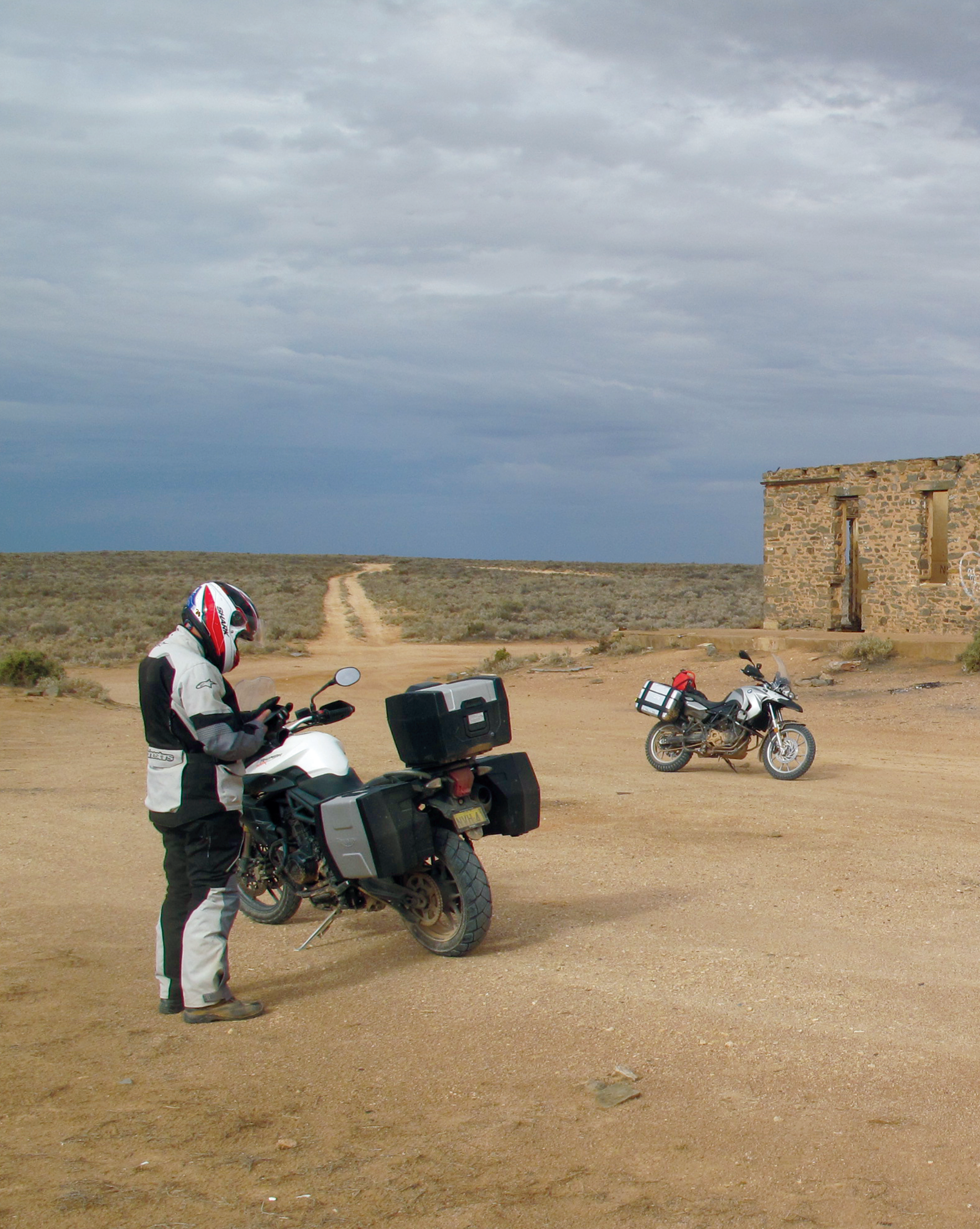
The Goyder Line runs roughly east-west across South Australia joining places with an average annual rainfall of 250mm. North of the line rainfall is usually too low to support cropping. The Line marks the change between mallee scrub to the south and saltbush to the north. Graeme Sedgwick set out to ride the divide, and although the forecast was chancy, he wasn’t going to be deterred by the possibility of rain.
 The ruins of Waukaringa township’s Gold Rush Hotel.
The ruins of Waukaringa township’s Gold Rush Hotel.
Mildura was the perfect rendezvous. Victoria’s largest Sunraysia river settlement is a major horticultural centre, supplying some 80 per cent of Victoria’s grapes. It was as good a place as any to meet a Tiger-riding mate and we departed to roughly follow Goyder’s Line. At the end of the ride our objective was to enjoy some beers and burgers at, of all places, the Palace Hotel in Broken Hill.We expected that would deal with any mid-year doldrums.
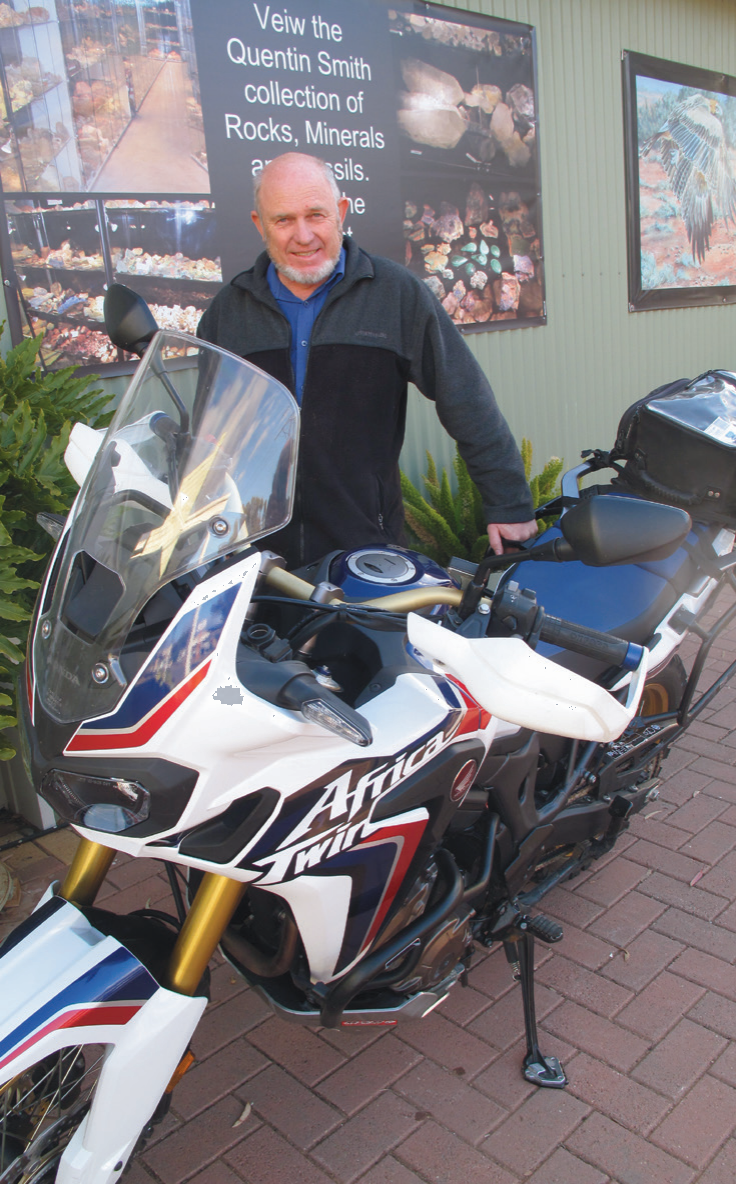 Former grader operator, orchardist and house painter, Jeff Morgan is a Hawker resident and prominent artist. He’s also a keen adventure rider.
Former grader operator, orchardist and house painter, Jeff Morgan is a Hawker resident and prominent artist. He’s also a keen adventure rider.
Remembered
Nestled within the relaxed surrounds of the Bald Hills, Burra was our first landmark. Regarded as one of South Australia’s best-preserved towns of the Victorian era, the settlement began as a single-company mining township in the 1850s. When the copper ran out it shrunk dramatically to become a service centre for agriculture.
Gentle terrain and the largely traffic-free roads encouraged a brisk run to Peterborough, from where we steered northwest to Orroroo.Believed to mean ‘Place Of Magpie’, Orroroo, like many other townships north of Goyder’s Line, has become a streetscape of fading prosperity.
As we journeyed through the desertedthoroughfares the afternoon sun punched out a magnificent pallet of reds, oranges, mustards and saturated greens under a near-perfect cloudless and equally vivid blue sky. It was hard to imagine the enormous heartbreak and bankruptcy of earlier times.
Crumbling remains of walls and stone chimneys stood testament as we diverted north away from ‘The Line’, which cut south through Crystal Brook, Moonta, then west across Spencer Gulf to Amo Bay, then across the Eyre Peninsula to Ceduna.
There was a strange motivation to throttle on between the contrasting fields of wind-turbine generators, decaying buildings and fading localities before our day’s final blast up to Hawker in the Flinders.
 Author Graeme Sedgwick surrendered to the Flinders’ scenery.
Author Graeme Sedgwick surrendered to the Flinders’ scenery.
Celebrated
South Australia’s Flinders Ranges stretch some 430km from Port Pirie northward to Lake Callabonna northeast of Arkaroola.
Callabonna is considerably smaller than Lake Eyre and is named after the first European explorer to walk through the Flinders Ranges. Some might say Callabonna was comparable to an equally adventurous South Australian motor-cyclist, Kevin Rohrlach, the first to reach Lake Eyre by motorcycle. Rohrlach later set 27 land speed records across its salt flats in the 1960s. That was in between drag racing on the Marabel quarter-mile, stunt riding at country shows and scrambling.
As darkness closed on our day’s lazy 500km or so, we celebrated our circumstances free of wet bums inside Hawker’s pub as nature unleashed a downpour outside.
 The arid country’s mood was serene and windless.
The arid country’s mood was serene and windless.
Avoided
Surveyed in 1880 as part of the Great Northern Railway, Hawker is the southern Flinders’ major service centre and home of artist Jeff Morgan.A former grader operator, orchardist, house painter, and blessed with the ‘gift’ of dyslexia, Jeff’s unique artistic skills show amazing 3D effects and panoramic works. Jeff’s also an enthusiastic adventure rider. His latest mount is an Africa Twin, which he reckons has the best suspension and through-the-gears acceleration of any bike he’s ridden.
Judging by the glint in his clear eyes he’s ridden more than a few over many years throughout the ranges he knows so well. With blue skies beckoning, and charged with Jeff’s infectious energy,we headed out to localities east, south, north and west of Hawker. First we found Willow Plains Settlers Monument, then the country east of Niggly Gap in the lower reaches of the Druid and Black Ranges. Southward lay Craddock and a chat with a modest publican, then we retraced our passage via the Moralana region and west to the main highway and Leigh Creek. It was a fuss-free gravel ride through waterless creeks surrounded by more wildlife traffic than one could reasonably be expected to count, and highlighted why travel after dusk might as well be a death wish. The abundance and size of the moving wildlife targets, if hit, guaranteed to bust and bloody the most robust of men and machines.
We took the highway’s safer return passage to Hawker pub.
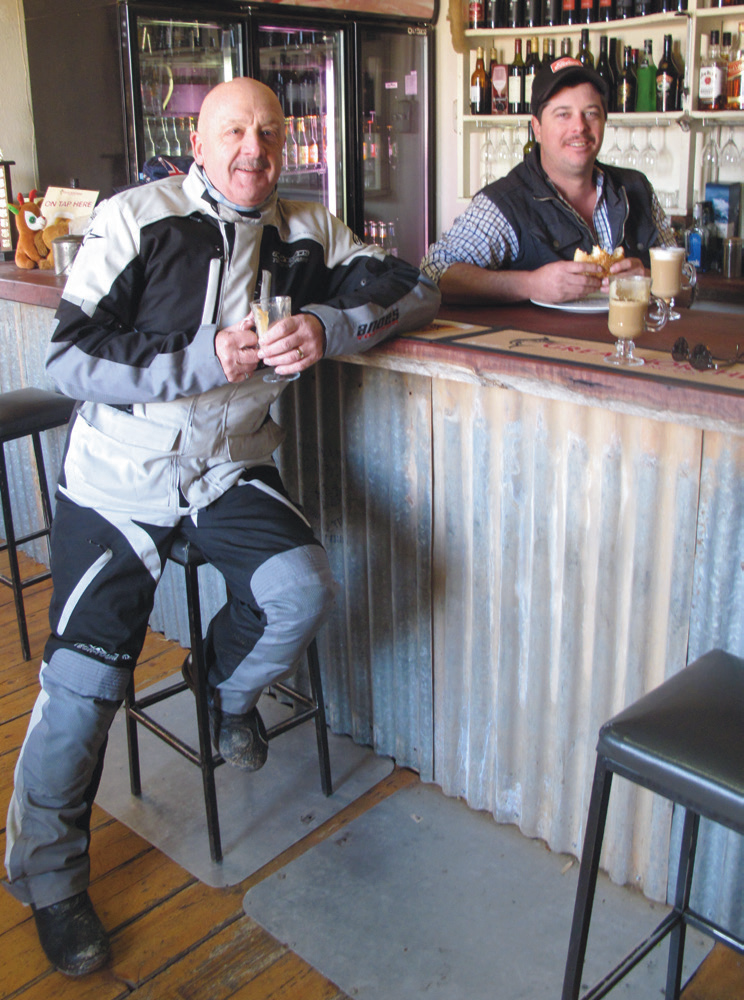 A coldie at the Craddock Hotel.
A coldie at the Craddock Hotel.
Dined
Back in Hawker we acted on advice from the pub’s staff and got our dinner orders in early, and it was lucky we did. Suddenly, out of nowhere, the bar and dining rooms were chockers.
The crowd was made up of nomads and allsorts in spotlighted, bull-barred 4WDs hitched to all types of off-road camper trailers and caravans. The out-pouring blur of colours, shapes, sizes and storytelling ruckus muffled cracks of lightning, thunder and the arrival of more rain on the corrugated iron.
We couldn’t believe our fortunes.
We’d escaped the indignity of wet backsides again!
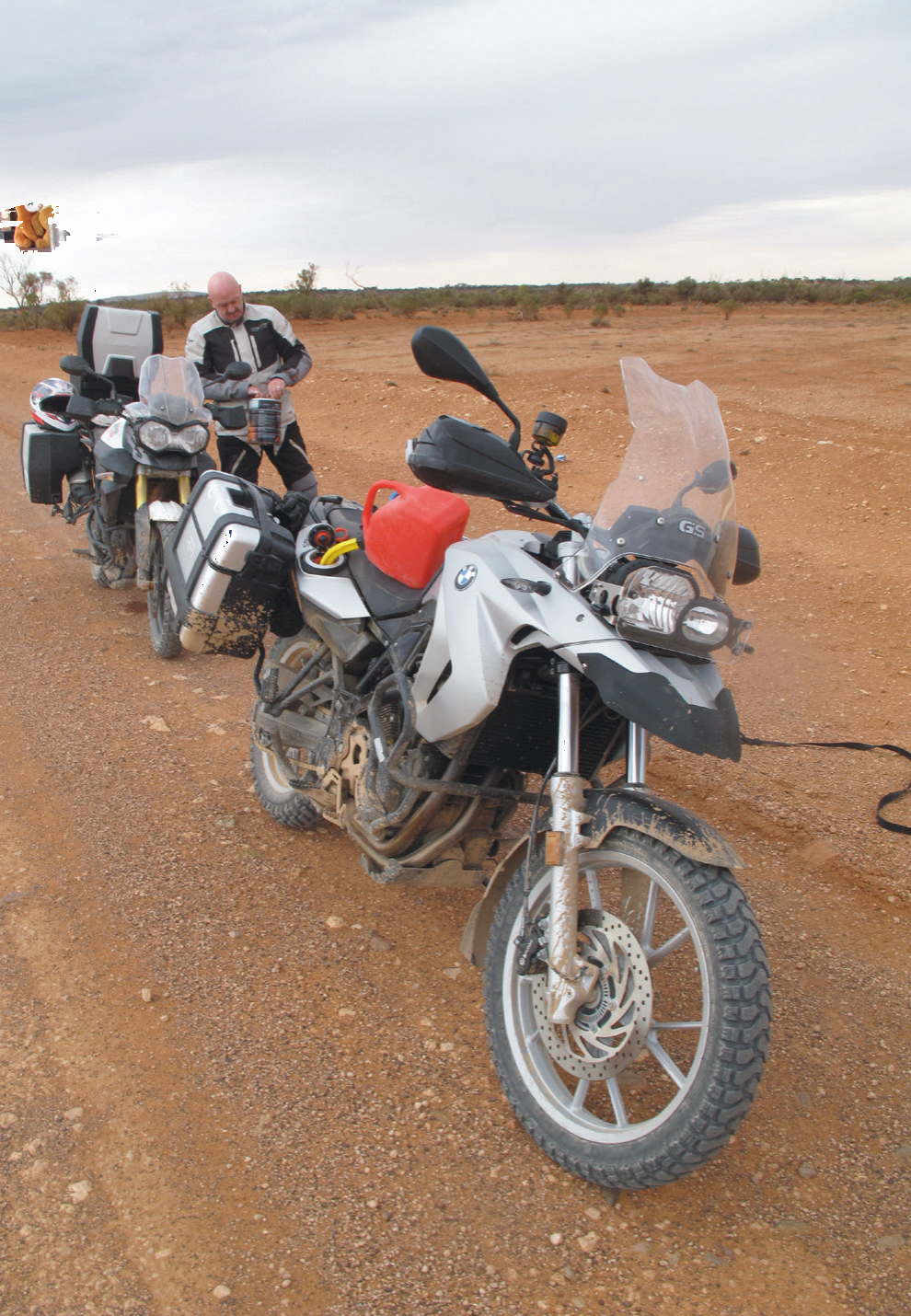
Pounded
We started early next morning to take advantage of the night’s rain gluing together the dirt-road surfaces, a phenomenon we’d discovered during previous Flinders’ rides. Starting early also gave us time to experiment with Trevor’s neat new iPhone lens kit.
The Struman lens set attached easily and simply to expand the versatility of his latest iPhone’s camera. The total size of the lens pack, inclusive of carry bag, three lenses and an adaptor, was less than an average fist.
We headed toward the best-known feature in the Flinders: Wilpena Pound.
Although to this day it’s not clear who discovered the Pound, it became a national tourist resort in 1945 when government bought its lease after many pastoralists who’d invested heavily had failed. Two years later that enabled Bond’s Tours to seize the moment and build Wilpena’s first chalet.
Our ride to Wilpena took many deviations, exploring anything and everything that looked like an adventure, before ending another wet-arse-free day.
 Might have to wait a while.
Might have to wait a while.
Gorged
Another cloudless blue sky kickstarted the next day and Bunyeroo Valley was first on our list. Its sheer size offered any amount of trails and tracks to enjoy.
The gorge’s ups and downs immediately got our attention and every change of direction needed care.
With Bunyeroo’s razorback country behind us we entered Brachina Gorge, more or less following the creek bed in the wandering valley. It was picturesque, with plenty of rocks, and punctuated with more camping spots than one might think. Brachina is loaded with options and notoriety. Its rocky passage hosted the first of the world’s more-recent trans-continental rally adventures in 1968, and when the water is flowing it becomes an even more interesting ride.
 Coffee and snacks in Parachilna before heading to Blinman Gorge.
Coffee and snacks in Parachilna before heading to Blinman Gorge.
Wedgied
Emerging from Brachina, we turned north up the bitumen and weaved between road-kill carcasses on our way to the Prairie Hotel at Parachilna. Wedge-tailed eagles of all sizes enjoyed the fresh pickings, and after our safe arrival we recharged with coffee and snacks before hitting the Parachilna to Blinman Gorge route, once used as a commercial passage to cart copper from Blinman mines.
Eleven kilometres into the gorge it seemed as if we were riding downwards through layers of sediment in the order they were deposited more than 500 million years ago. There were plenty of camp clearings to kick back and enjoy some stargazing.
A little further on was Angorichina, established to accommodate tuberculosis sufferers. The climate and surroundings were claimed to be perfect for treating TB, and while we didn’t put that to the test, it was also our last chance to refuel before our next day’s arid-country adventure.
 Outback signwriting.
Outback signwriting.
Brewed
Gammon Ranges National Park, also referred to as The Northern Flinders, grew from an amalgamation of pastoral lands acquired from the Yancaninna pastoral lease and a large portion of the Balcanoona plains. Joining the park with Lake Frome made an area of some 128,000 or so hectares which is home to heaps of yellow-footed rock-wallabies and many interesting birds and flowers.
There’s also spectacular geological features and significant aboriginal art.
A 28km deviation via Glass Gorge that’s technically more demanding offers a number of high points to view the Gammon Ranges, but we didn’t take that option this time.
We rolled into Blinman, a town named after shepherd Robert Blinman, who found copper. The locality was mined for some 30 years with mixed success, and it’s now a quirky outpost with a pub that offers the broadest of beer choices and good tucker.
We were unexpectedly given a treat by a quite personable lone traveller, who introduced himself as Ross, and enthusiastically knocked tops off bottles of his home-brewed ginger beer varieties. I hasten to say the brew hit the spot perfectly after another rainless day in the saddle.

Holed
Keen to commence the next day’s run east into the arid country, we departed under threatening grey skies carrying extra fuel in case either of our standard tanks fell short.
Just outside Wirrealpa we had the opportunity to turn to Mount Chambers, a place aboriginals named in the belief a mythical person threw a boomerang which cut a fracture through the mountain, in the process creating a knob atop as it spun back.
Next was Wearing Gorge, flanked by trees either side of the road, before the open landscape known as Tea Tree Outstation where we turned southward.
The smell of rain was all around and, compared to previous warm days, we were feeling some wind chill.
The question, we agreed, wasn’t if it would rain, but how big would the drops be? And would they make the ball-bearing surface a little tacky? Or would the rain, in a heartbeat, morph the surface into swimming pools of glue? Either way progress demanded our fullest attention amid freshening wind. The partly graded, deep, heavy, loose-gravelled surface provided plenty of handling entertainment and allowed little rest unless one stopped to spot landmarks like the State’s vermin-proof fence tracking its way across the flat, bland country.
Several cattle grids later, ironically over one which had caught a ’roo, things changed and allowed us to lift our pace.
We hauled in sights like Lake Frome Down Station’s sheds, homestead and stock yards before Coondappie Ruins and Erudine Woolshed.
By this stage it seemed as if we were riding below the hole in a doughnut, only this doughnut’s ring was made of dark, grey, rain-filled clouds.
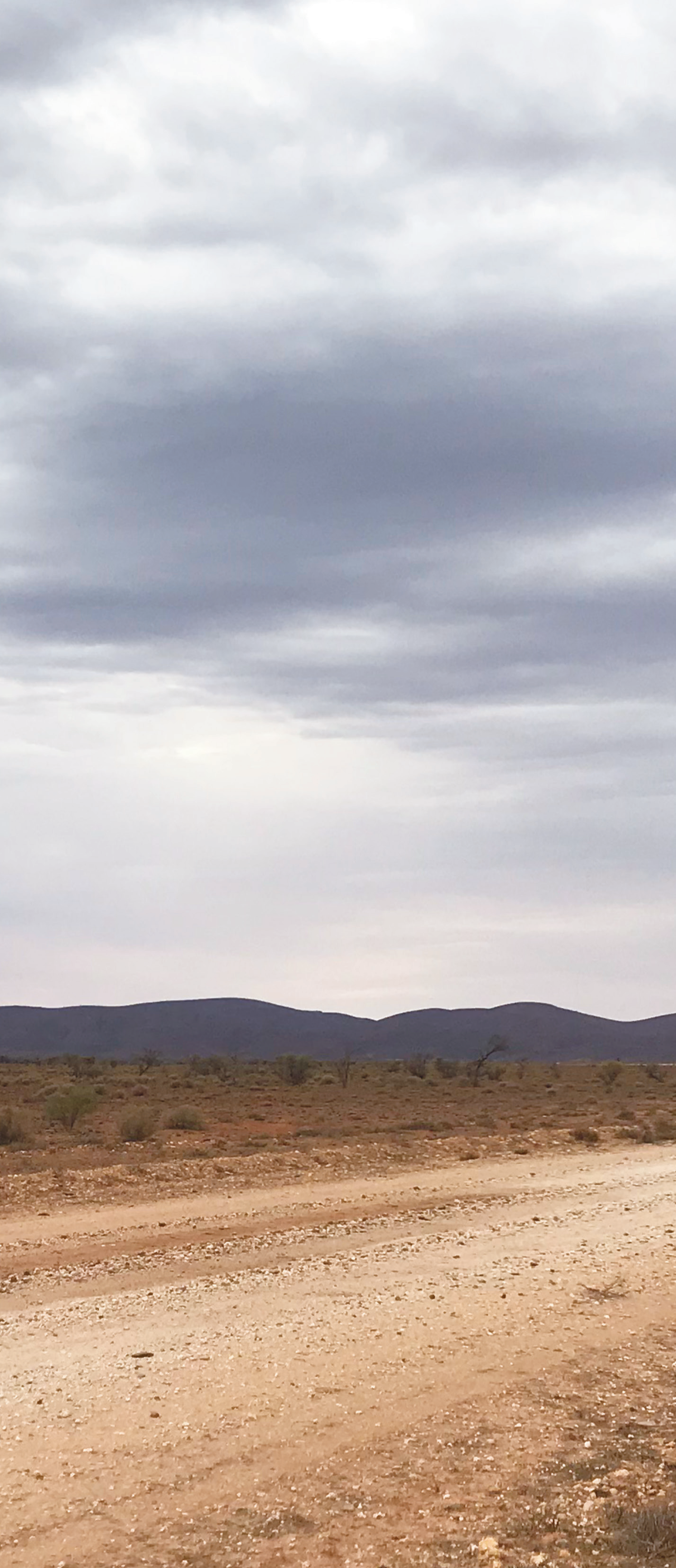 The threat of rain didn’t deter the riders.
The threat of rain didn’t deter the riders.
Abondoned
Curnamona came and went, lost within increasingly gentle hills. Toolab faded to the east and features such as Black Hill,Nillinghoo Hill, then Gordon Hill to the west and Mt Victor to the east passed before Koonamore also vanished as we rode by Bickmore Hill to our east.
We were surrounded by the enormity of Melton Station when we stopped to refuel from our supplies, and the arid country’s mood was serene and windless. Ahead were the remains of the former town of Waukaringa. It had been abandoned in the 1950s and the most significant remaining structure was the hotel.
Standing defiant, the pub ruins honoured those halcyon gold-mining days when some 750 people populated the area and approximately 1427kg of gold was mined between 1873 and 1969.
It was tough to grasp the hotel had operated until 1970, merely 48 years ago, and was just 34km from Yunta on the Barrier Highway.
 Beers and burgers at Broken Hill’s Palace Hotel to celebrate a successful ride.
Beers and burgers at Broken Hill’s Palace Hotel to celebrate a successful ride.
Finished
In Yunta our arid-country crossing was complete and marked by yet another cloudless, bright-blue sky. We’d chanced it and made it without wet arses.
The sun, now behind us, highlighted the vivid colours of the landscape and we cracked open the throttles to make Broken Hill before dusk. That final and brisk run couldn’t have been more exhilarating. Cresting the railway flyover before the outskirts of Broken Hill with the sun on the horizon was a spectacular image to hold over burgers washed down with beers at the flamboyant Palace Hotel. Built as a coffee palace in 1889 at a cost of £12,190, the Palace is now an icon, thanks to its featuring in The Adventures Of Priscilla, Queen Of The Desert.
It was the perfect chance to quench a thirst and ponder another adventure.







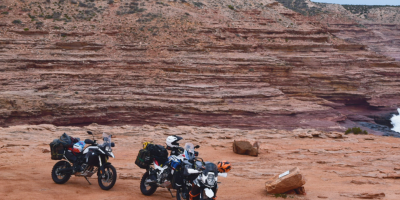






Comments